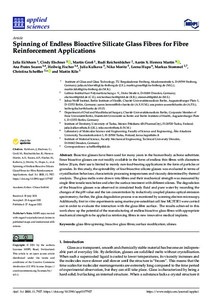Spinning of Endless Bioactive Silicate Glass Fibres for Fibre Reinforcement Applications
Eichhorn Julia; Elschner Cindy; Groß Martin; Reichenbächer Rudi; Martín Aarón X. Herrera; Soares Ana Prates; Fischer Heilwig; Kulkova Julia; Moritz Niko; Hupa Leena; Stommel Markus; Scheffler Christina; Kilo Martin
Spinning of Endless Bioactive Silicate Glass Fibres for Fibre Reinforcement Applications
Eichhorn Julia
Elschner Cindy
Groß Martin
Reichenbächer Rudi
Martín Aarón X. Herrera
Soares Ana Prates
Fischer Heilwig
Kulkova Julia
Moritz Niko
Hupa Leena
Stommel Markus
Scheffler Christina
Kilo Martin
MDPI
Julkaisun pysyvä osoite on:
https://urn.fi/URN:NBN:fi-fe2022021519217
https://urn.fi/URN:NBN:fi-fe2022021519217
Tiivistelmä
Bioactive glasses have been used for many years in the human body as bone substitute. Since bioactive glasses are not readily available in the form of endless thin fibres with diameters below 20 mu m, their use is limited to mainly non-load-bearing applications in the form of particles or granules. In this study, the spinnability of four bioactive silicate glasses was evaluated in terms of crystallisation behaviour, characteristic processing temperatures and viscosity determined by thermal analysis. The glass melts were drawn into fibres and their mechanical strength was measured by single fibre tensile tests before and after the surface treatment with different silanes. The degradation of the bioactive glasses was observed in simulated body fluid and pure water by recording the changes of the pH value and the ion concentration by inductively coupled plasma optical emission spectrometry; further, the glass degradation process was monitored by scanning electron microscopy. Additionally, first in vitro experiments using murine pre-osteoblast cell line MC3T3E1 were carried out in order to evaluate the interaction with the glass fibre surface. The results achieved in this work show up the potential of the manufacturing of endless bioactive glass fibres with appropriate mechanical strength to be applied as reinforcing fibres in new innovative medical implants.
Kokoelmat
- Rinnakkaistallenteet [27094]
